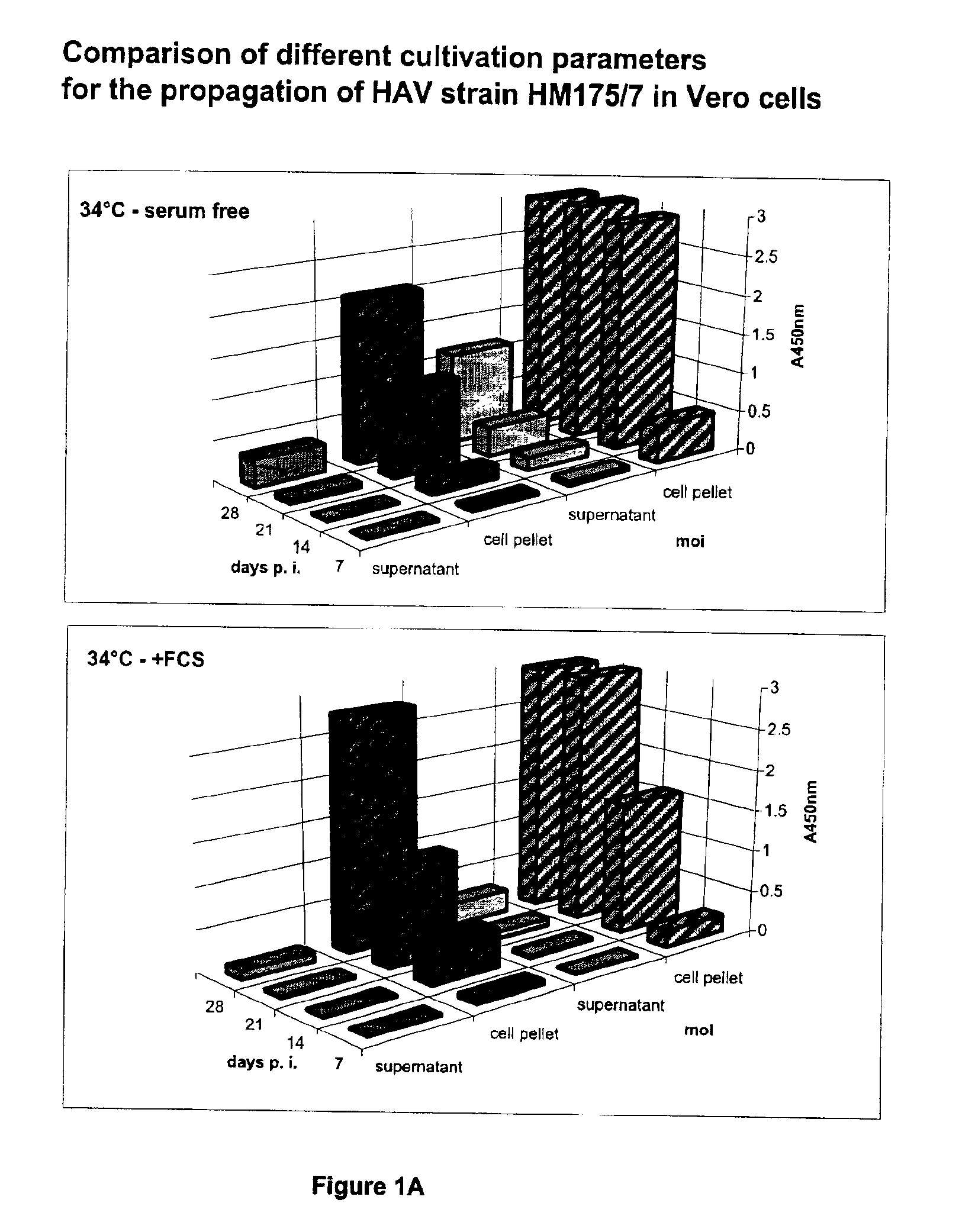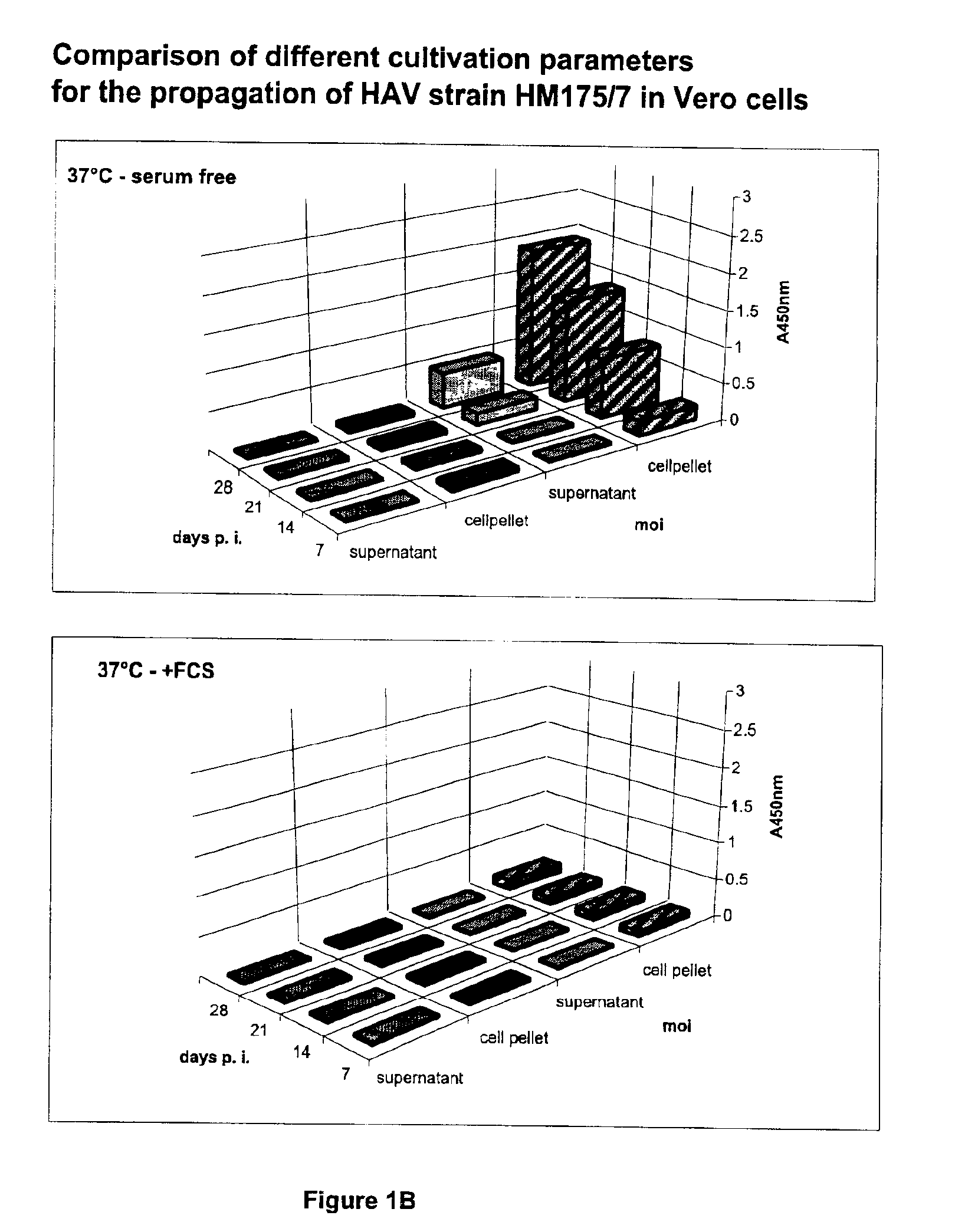Method of large scale production of Hepatitis A virus
a technology large-scale production, which is applied in the field of large-scale production of hepatitis a virus, can solve the problems of sporadic infections, endemics, occasional deaths, and virus propagation is usually difficult, and the effect of long incubation period cannot be attributed to cytopathic
- Summary
- Abstract
- Description
- Claims
- Application Information
AI Technical Summary
Benefits of technology
Problems solved by technology
Method used
Image
Examples
example 1
Propagation of HAV on VERO Host Cell System
[0037]The HAV strain HM175 / 7 (kindly provided by Robert Purcell, National Institute of Health, Bethesda, Md.) which has initially been isolated by a clinical specimen and has been serial passaged in primary African green monkey cells, which led to the attenuation of the virus strain, is tested for propagation on VERO cell microcarrier culture.
[0038]VERO cells (African Green Monkey, Cercopthecus aethiops, kidney) are used as production cell line. The cells have been obtained from the American Type Cell Culture Collection, Rockville, Md. at a passage number 124 under the designation ATCC CCL 81. The cells are adapted to grow in serum-containing, serum-free, or serum- and protein free medium as described in Kistner et al. (1998. Vaccine 16:960-968) or WO 96 / 15231. For growth in serum free medium a basal DMEM HAM's F12 medium supplemented with inorganic salts, amino acids, sodium bicarbonate (2 g / l) and yeast or soy bean extract (1-10 g / l) is u...
example 2
Preparation of HAV Virus Stock for Large Scale Production
[0042]Full length cDNA of the genome of attenuated strain HM175 / 7 cloned in the bacterial plasmid pHAV / 7 (Cohen et al., 1987, J. Virol. 61:3035-3039) is used to prepare full length genomic RNA by in vitro transcription. Serum free VERO cells at 34° C. are transfected with in vitro transcribed HAV RNA to generate virus stocks free of adventitious agents. After 6 weeks, HAV specific antigen is detected in the lysate of infected cells which are used to further propagate HAV on VERO cells under serum free conditions. Table 1 shows the antigen and the virus titer produced after serial passages. The infected cells released approximately 50% of the viral antigen in the cell supernatant. After the 4th passage, the virus stock has a titer of 8×107TCID 50 / ml.
TABLE 1Antigen and Virus Titer of serial passages of HAV strain HM175 / 7 aftertransfection of serum free VERO cellsPassages afterTotal Antigen (EU)Total Titer (TCID50)transfectionsup...
example 3
Propagation of HAV HM175 / 7 on VERO Cells in Serum Free Medium
[0044]HAV HM175 / 7 as obtained according to Example 2 is serially passaged in serum free VERO cells at 34° C. On day 7, 14, and 21 after infection the infectious titer and the amount of antigen is determined (Table 2).
TABLE 2Propagation of HAV strain HM175 / 7 on serum free VERO cells at 34° C.Antigen (EU / 5 × 107 cells)Titer (TCID50 / 5 × 107 cells)Passage No.supernatantcell pelletsupernatantcell pellet 7 dneg. 1 6001.3 × 1071.1. × 107 14 d 3 20025 6001.8 × 1082.3 × 10821 d25 60051 2002.1 × 1095.1 × 108
[0045]Virus titers of 5×108 and 2×109 per 5×107 cells are obtained in the cell pellet and the cell culture supernatant, respectively. This demonstrates that viral antigen is persistently released in the cell culture supernatant by the serum free VERO cells. Three weeks post infection (p.i.) the percentage of the viral antigen in the cell culture supernatant is about 50%, while approximately 75% of the infectivity is localized the...
PUM
| Property | Measurement | Unit |
|---|---|---|
| Temperature | aaaaa | aaaaa |
| Temperature | aaaaa | aaaaa |
| Fraction | aaaaa | aaaaa |
Abstract
Description
Claims
Application Information
 Login to View More
Login to View More - R&D
- Intellectual Property
- Life Sciences
- Materials
- Tech Scout
- Unparalleled Data Quality
- Higher Quality Content
- 60% Fewer Hallucinations
Browse by: Latest US Patents, China's latest patents, Technical Efficacy Thesaurus, Application Domain, Technology Topic, Popular Technical Reports.
© 2025 PatSnap. All rights reserved.Legal|Privacy policy|Modern Slavery Act Transparency Statement|Sitemap|About US| Contact US: help@patsnap.com


